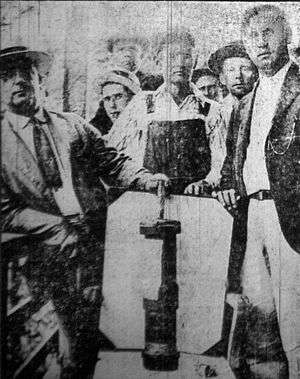West Virginia coal wars
|
Coal miners displaying a bomb that was dropped during the Battle of Blair Mountain in 1921 | |
| Date | 1912–1921 |
|---|---|
| Location | West Virginia, United States |
| Also known as | Mine wars |
The West Virginia coal wars (1912–21), also known as the mine wars, arose out of a dispute between coal companies and miners. The first workers strike, in West Virginia, was the Cabin Creek and Paint Creek strike of 1912-1913.[1] With help from Mary "Mother" Jones, an important figure in unionizing the mine workers, the miners demanded better pay, better work conditions, the right to trade where they pleased, and recognition of the United Mine Workers (UMW).[2] The mining companies, however, refused to meet the demands of the workers and instead hired Baldwin-Felts Agents, equipped with high-powered rifles, to guard the mines, but more important to be strikebreakers.[2][1] After the Agents arrived, the miners either moved out or were evicted from the houses they had been renting from the coal companies, moving into coal camps that were being supported by the Union.[1] Approximately 35,000 people lived in these coal camps.[1] It wasn't until a month after the strike began that it became hostile with the arrival of the Baldwin-Felts Agents who provoked the miners.[1] The union began supplying miners with weapons: 6 machine guns, 1,000 high-powered rifles, and 50,000 rounds of ammunition.[1]
The climax of the wars occurred September 1, 1912, when around 6,000 unionized miners from across the Kanawha River crossed the river and declared their intent to kill the mine guards and destroy the company operations.[1] Due to this threat the mining companies deployed additional armed guards and awaited the miners' attack.[1] Consequently, the Governor proclaimed martial law to be in effect on September 2, 1912, seizing 1,872 high-powered rifles, 556 pistols, 6 machine guns, 225,000 rounds of ammunition, and 480 blackjacks, as well as large quantities of daggers, bayonets, and brass knuckles.[1]
On May 19, 1920, a shootout in Matewan, West Virginia, between agents of the Baldwin-Felts and local miners, who later joined the United Mine Workers of America, sparked what became known as the Battle of Blair Mountain, the largest insurrection in the United States since the American Civil War.
The shootout is re-enacted annually in Matewan, West Virginia.[3]
John Sayles dramatized these events in his 1987 film Matewan.[4]
Notes
- 1 2 3 4 5 6 7 8 9 Wheeler, H. N.. (1976). Mountaineer Mine Wars: An Analysis of the West Virginia Mine Wars of 1912-1913 and 1920-1921. The Business History Review, 50(1), 69–91.
- 1 2 Blizzard, W. C., & Harris, W. (2010). When Miners March. Oakland, Calif: PM Press.
- ↑ Herald Dispatch (Huntington, WV: "West Virginia filled with festivals for this upcoming weekend," May 13, 2008, accessed December 14, 2010
- ↑ Internet Movie Database: Matewan (1987), accessed December 14, 2010
References
- Bailey, Rebecca J., Matewan before the Massacre: Politics, Coal, and the Roots of Conflict in a West Virginia Mining Community (West Virginia University Press, 2008)
- Corbin, David Alan, Life, Work, and Rebellion in the Coal Fields: The Southern West Virginia Miners, 1880-1922, new ed. (Urbana, IL: University of Illinois Press, 1981), ISBN 0-252-00895-2
- Corbin, David Alan, ed., The West Virginia Mine Wars: An Anthology (Charleston, WV: Appalachian Editions, 1990), ISBN 0-9627486-0-9
- Hamilton, Neil A., "West Virginia Mining District Erupts in Violence at Matewan and Blair Mountain," Rebels and Renegades: A Chronology of Social and Political Dissent in the United States (NY: Routledge, 2002), available online in part
- Laurie, Clayton D., "The United States Army and the Return to Normalcy in Labor Dispute Interventions: The Case of the West Virginia Coal Mine Wars, 1920-1921" West Virginia History, vol. 50 (1991), available online
- Lee, Howard B., Bloodletting in Appalachia: The Story of West Virginia's Four Major Mine Wars and Other Thrilling Incidents of Its Coal Fields (Morgantown, WV: West Virginia University Library, 1969), ISBN 0-87012-041-7
- Owens, John W., "Gumen in West Virginia," New Republic, September 21, 1921, available online
- Savage, Lon, Thunder in the Mountains: The West Virginia Mine War, 1920-21 (Pittsburgh: University of Pittsburgh Press, 1990), ISBN 0-8229-3634-8, available online in part
- Scholten, Pat Creech, "The Old Mother and Her Army: The Agitative Strategies of Mary Harris Jones," West Virginia History, vol. 40 (Summer 1979)
- Shogan, Robert, The Battle of Blair Mountain: The Story of America's Largest Labor Uprising (Boulder, CO.: Westview Press, 2004), ISBN 0-8133-4096-9, available online in part
- Sullivan, Ken, ed., The Goldenseal Book of the West Virginia Mine Wars (Charleston, WV: Pictorial Histories Publishing Company, 1991), ISBN 0-929521-57-9
- Torok, George D., A Guide to Historic Coal Towns of the Big Sandy River Valley (University of Tennessee Press, 2004), available online in part
- United States Senate, Hearings before the Committee on Education and Labor (2 vols., 1921), available online
